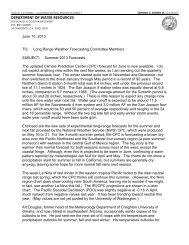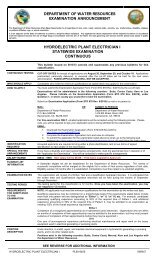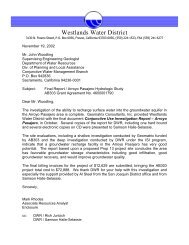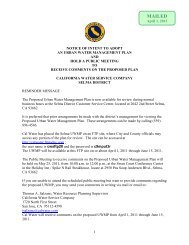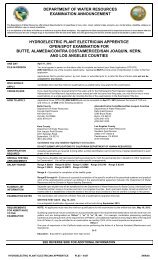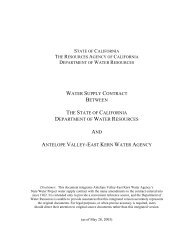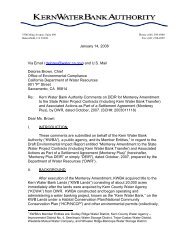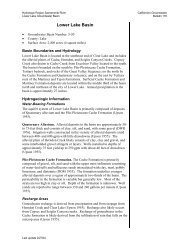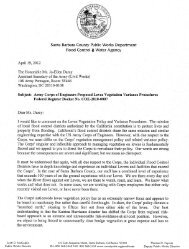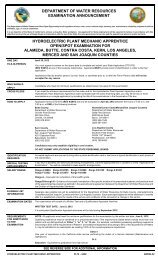Bulletin 1.pdf - California Department of Water Resources - State of ...
Bulletin 1.pdf - California Department of Water Resources - State of ...
Bulletin 1.pdf - California Department of Water Resources - State of ...
Create successful ePaper yourself
Turn your PDF publications into a flip-book with our unique Google optimized e-Paper software.
WATER RESOURCES OF CALIFORXIA 645<br />
acre-feet guaranteed by the treaty. This quantity, which may be made<br />
up <strong>of</strong> any waters <strong>of</strong> the Colorado from any and all sources, whether<br />
direct river flow, return flow, or seepage, will be delivered by the United<br />
<strong>State</strong>s in the boundary portion <strong>of</strong> the river, except that until 1980<br />
Mexico may receive 500,000 acre-feet annually, and after that year<br />
375,000 ·acre-feet annually, through the All-American Canal as part <strong>of</strong><br />
the guaranteed quantity. Davis Dam has been built by the United <strong>State</strong>s<br />
to provide regulation <strong>of</strong> flow required to meet commitments <strong>of</strong> the Mexican<br />
treaty. The treaty provides that Mexico shall construct, at its expense,<br />
a main diversion structure below the point where the northernmost part<br />
<strong>of</strong> the international land boundary line intersects Colorado River. In<br />
complying with this provision, the Mexican Government has constructed<br />
Morelos Dam on Colorado River about five miles southwest <strong>of</strong> Yuma.<br />
Since February, 1942, all water delivered to the Alamo Canal through<br />
the Pilot K.nob Wasteway <strong>of</strong> the All-American Canal, plus water diverted<br />
from the Colorado into the Alamo Canal, has been used in Mexico.<br />
For the major part <strong>of</strong> its length between Hoover Dam and Havasu<br />
Lake created by Parker Dam, the Colorado flows in well confined canyon<br />
sections where there is little opportunity for meandering. There is, however,<br />
an exception to this general topography immediately upstream from<br />
Topock, where the river flows through an alluvial valley about 33 miles<br />
long and from two to five miles wide. In years past the river has meandered<br />
through this valley, with general aggradation <strong>of</strong> the valley floor.<br />
.As a result, the river now spreads over almost the full width <strong>of</strong> the lower<br />
half <strong>of</strong> this valley, forming a swamp through which water flows in a<br />
number <strong>of</strong> small channels, with resulting heavy water losses. The United<br />
<strong>State</strong>s Bureau <strong>of</strong> Reclamation has a channel rectification project under<br />
construction in this reach.<br />
Natural Flow <strong>of</strong> Colorado River Above Gila River<br />
Katural flow <strong>of</strong> Colorado River above Gila River was determined<br />
by deducting recorded flow <strong>of</strong> Gila River at Dome from that <strong>of</strong> Colorado<br />
River at Yuma, and correcting the resulting record for effects <strong>of</strong> upstream<br />
regulation, diversion, and irrigation consumptive uses on the main Colorado<br />
River and upstream tributaries. Records <strong>of</strong> flow <strong>of</strong> Colorado River<br />
at Yuma and <strong>of</strong> Gila River at Dome are available for the entire period<br />
from 1904-05 to 1947-48 used in the current study.<br />
Regulation, diversions, and irrigation consumptive uses in the Upper<br />
Basin <strong>of</strong> the Colorado were estimated as set forth in the discussion <strong>of</strong> the<br />
natural flow at Lee Ferry. Similarly, impairments to natural flow <strong>of</strong> the<br />
river in the Lower Basin were estimated by reaches above and below<br />
Hoover Dam.<br />
Irrigation diversions above Hoover Dam include those from the Virgin<br />
and Little Colorado Rivers, and Kanab Creek. Available records from<br />
the Bureau <strong>of</strong> Censns were used to estimate annual irrigated acreage<br />
segregated by stream systems. These acreages were then multiplied by<br />
estimated unit values <strong>of</strong> seasonal consumptive use, which were computed<br />
separately for each stream system.<br />
Diversions from the Colorado below Hoover Dam are mainly for<br />
irrigation. Records are available covering practically the entire period<br />
during which these diversions have been made. Consumptive use was<br />
estimated for the few periods or diversions for which no records were



